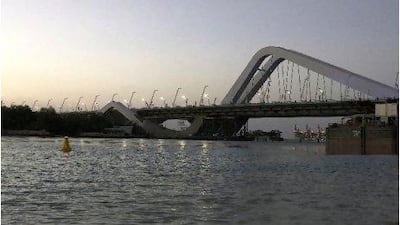ABU DHABI // The Dh1 billion Sheikh Zayed Bridge was officially opened last night with a ribbon cutting ceremony conducted by Sheikh Khalifa, the President of the UAE.
The 842-metre construction, which spans the Maqta Channel, is the fourth bridge to link Abu Dhabi to the mainland and has been almost eight years in construction.
The bridge, which was designed by the Iraqi-born British architect Zaha Hadid, has been mired in delays and budget overruns, and had initially been due for completion more than three years ago.
Sheikh Khalifa said the bridge would herald further achievements for the UAE, which would place the nation among the most advanced countries in the world, according to the official news agency, WAM.
"The bridge which bears the name of our father, the late Sheikh Zayed bin Sultan Al Nahyan, is more than a link between two points," he was quoted by WAM as saying.
"It is a symbol for the continuous development process started by the late Sheikh Zayed and an evidence to our determination to pursue the goals of Plan Abu Dhabi 2030," he said.
The opening ceremony was also attended by Sheikh Mohammed bin Zayed, Crown Prince of Abu Dhabi and Deputy Supreme Commander of the UAE Armed Forces, and a host of senior government figures such as Sheikh Saif bin Zayed, the Minister of Interior.
After cutting the ribbon, Sheikh Khalifa viewed the designs and plans for different phases of the bridge's construction.
Abu Dhabi Municipality announced last month that construction work on the bridge had been completed, but did not announce when it would be opened to the public.
Officials said that only a few final details, such as laying tiles for the emergency footpath, painting, signage on the links between both ends of the bridge and some dredging had yet to be completed.
The bridge is composed of three main arches, made of steel and mounted on concrete supports. The arches and cables support two four-lane carriageways, an emergency lane and a pedestrian walkway, running through and alongside the roller-coaster framework.
It is a mark of Abu Dhabi's rapidly accelerating expansion that when the bridge was originally designed it featured only two lanes in each direction; as the city's population expanded, planners realised they needed to double its capacity and the design was amended.
The arch of the central span soars 63m high; more than two-thirds of the height of the nearby Sheikh Zayed Grand Mosque. The bridge is designed to withstand wind gusts of 160 kilometres per hour. It has three sand dune-shaped arches linked together by concrete blocks that are reinforced with steel wires.
The bridge is also designed to absorb double the average traffic load. The 666 concrete pillars were constructed using 480 tons of concrete, 5,000 tons of pre-stressed steel structure and 2,000 tons of foundation steel.

